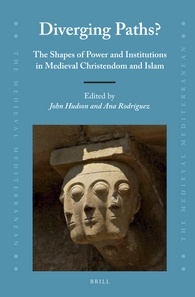“Diverging Paths? The Shapes of Power and Institutions in Medieval Christendom and Islam” (Brill 2014) received a stellar review to be included in the “The Medieval Review”. The book is edited by our own John Hudson and long-time friend of St Andrews Ana Rodríguez (CCHS-CSIC), and it emerges from work undertaken in the related projects “Diverging Paths” and “Power and Institutions in Medieval Islam and Christendom“, including contributions from John Hudson, Caroline Humfress, and Simon MacLean.
From the forthcoming review by Thomas W. Barton (University of San Diego):
This sophisticated volume illustrates the impressive, thought-provoking results an accomplished, diverse group of scholars can produce in pursuit of a simple and open-ended yet ultimately difficult and complicated question. Based on the level and manner of institutionalization of Islamic and Christian societies in the early medieval period, one would have expected their respective development by the late Middle Ages to be the reverse from what, in fact, transpired. For example, whereas Christendom witnessed the development of sophisticated medieval states and other exclusive economic and political organizations, Islamic societies were seemingly prevented by the nature of Islamic law from developing similarly elitist institutions. How can scholars account for this unexpected reversal in “institutionalisation and institutional continuity” (xi)? Funded by Spain’s Ministry of Science and Technology, a gathering of handpicked experts on premodern Islamic and Christian societies from around the world (but predominately Europe) participated in a number of meetings convoked by Ana Rodríguez and Eduardo Manzano at their Centro de Ciencias Humanas y Sociales of the Consejo Superior de Investigaciones Científicas (CSIC) in Madrid between 2009 and 2013. The project took the same name now borne by this handsome volume and pursued a fascinating and timely inquiry into the comparative institutional development of societies of the premodern Mediterranean, a topic that has of course interested historians for generations. Yet with a plethora of highly trained and interested experts and arguably more collaboration between scholars working on the formerly much too isolated Islamic and Christian sides of the Mediterranean world (encouraged by numerous and proliferating networking associations), academia has never been better prepared to tackle such a project.
in fact, transpired. For example, whereas Christendom witnessed the development of sophisticated medieval states and other exclusive economic and political organizations, Islamic societies were seemingly prevented by the nature of Islamic law from developing similarly elitist institutions. How can scholars account for this unexpected reversal in “institutionalisation and institutional continuity” (xi)? Funded by Spain’s Ministry of Science and Technology, a gathering of handpicked experts on premodern Islamic and Christian societies from around the world (but predominately Europe) participated in a number of meetings convoked by Ana Rodríguez and Eduardo Manzano at their Centro de Ciencias Humanas y Sociales of the Consejo Superior de Investigaciones Científicas (CSIC) in Madrid between 2009 and 2013. The project took the same name now borne by this handsome volume and pursued a fascinating and timely inquiry into the comparative institutional development of societies of the premodern Mediterranean, a topic that has of course interested historians for generations. Yet with a plethora of highly trained and interested experts and arguably more collaboration between scholars working on the formerly much too isolated Islamic and Christian sides of the Mediterranean world (encouraged by numerous and proliferating networking associations), academia has never been better prepared to tackle such a project.
It is uncommon to find an edited volume for which the whole is greater than the sum of its parts. Nevertheless, such is the case with Diverging Paths?, which manifests an impressive degree of synergy among its widely varied contributions. Nearly every essay could stand alone as a significant contribution to its respective field, yet the individual arguments become all the more intriguing and meaningful when presented within the broader context and comparative framework generated by the volume. This cumulative effect must be at least partly the result of sustained collaboration by these scholars over several years, enabling them to tweak their theoretical approaches and assumptions and ruminate adequately over the meanings of their results. It is also clearly owing to the hard work of the editors, who were evidently committed to expending the additional thought and work to generate the introductory and concluding materials necessary to tie these diverse studies together into a more meaningful aggregate for their readership. In sum, this well-presented volume offers its readers an array of perspectives on a subset of the comparative historical issues that are intriguing premodern scholars in a mode that will be challenging yet still accessible to non-specialists, while both highly engaging and valuable for experts.
When published, a full version of the review will be available here.